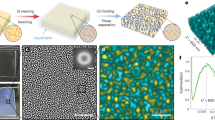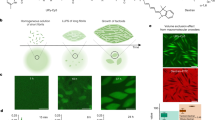Abstract
Phase separation is a central concept of materials physics1,2,3 and has recently emerged as an important route to compartmentalization within living cells4,5,6. Biological phase separation features activity7, complex compositions8 and elasticity9, which reveal important gaps in our understanding of this universal physical phenomenon. Here, we explore the impact of elasticity on phase separation in synthetic polymer networks. We show that compressive stresses in a polymer network can suppress phase separation of the solvent that swells it, stabilizing mixtures well beyond the liquid–liquid phase-separation boundary. Network stresses also drive a new form of ripening, driven by transport of solute down stiffness gradients. This elastic ripening can be much faster than conventional Ostwald ripening driven by surface tension.
This is a preview of subscription content, access via your institution
Access options
Access Nature and 54 other Nature Portfolio journals
Get Nature+, our best-value online-access subscription
$29.99 / 30 days
cancel any time
Subscribe to this journal
Receive 12 print issues and online access
$209.00 per year
only $17.42 per issue
Buy this article
- Purchase on Springer Link
- Instant access to full article PDF
Prices may be subject to local taxes which are calculated during checkout



Similar content being viewed by others
Code availability
The code that supports the findings of this study is available from the corresponding author on reasonable request.
References
Gibbs, J. W. On the equilibrium of heterogeneous substances. Trans. Conn. Acad. Arts Sci. 3, 108 (1876).
Cahn, J. W. & Hilliard, J. E. Free energy of a nonuniform system. I. Interfacial free energy. J. Chem. Phys. 28, 258 (1958).
Tanaka, H. Viscoelastic phase separation. J. Phys.: Condens. Matter 12, R207 (2000).
Brangwynne, C. P. et al. Germline P granules are liquid droplets that localize by controlled dissolution/condensation. Science 324, 1729 (2009).
Hyman, A. A., Weber, C. A. & Jülicher, F. Liquid-liquid phase separation in biology. Annu. Rev. Cell Dev. Biol. 30, 39 (2014).
Shin, Y. & Brangwynne, C. P. Liquid phase condensation in cell physiology and disease. Science 357, eaaf4382 (2017).
Weber, C. A., Zwicker, D., Jülicher, F. & Lee, C. F. Physics of active emulsions. Rep. Prog. Phys. 82, 064601 (2019).
Jacobs, W. M. & Frenkel, D. Phase transitions in biological systems with many components. Biophys. J. 112, 683 (2017).
Style, R. W. et al. Liquid-liquid phase separation in an elastic network. Phys. Rev. X 8, 011028 (2018).
Kim, J. Y. et al. Scale-free fracture in soft solids. Preprint at http://arXiv.org/abs/arXiv:1811.00841 (2018).
Shin, Y. et al. Liquid nuclear condensates mechanically sense and restructure the genome. Cell 175, 1481 (2018).
Veatch, S. L. & Keller, S. L. Separation of liquid phases in giant vesicles of ternary mixtures of phospholipids and cholesterol. Biophys. J. 85, 3074 (2003).
Vitale, S. A. & Katz, J. L. Liquid droplet dispersions formed by homogeneous liquid–liquid nucleation: ‘the ouzo effect’. Langmuir 19, 4105 (2003).
Rubinstein, M. & Colby, R. H. Polymer Physics (Oxford University Press, 2003).
Gent, A. N. & Wang, C. Fracture mechanics and cavitation in rubber-like solids. J. Mater. Sci. 26, 3392 (1991).
Zimberlin, J. A., Sanabria-DeLong, N., Tew, G. N. & Crosby, A. J. Cavitation rheology for soft materials. Soft Matter 3, 763 (2007).
Weber, C. A., Lee, C. F. & Jülicher, F. Droplet ripening in concentration gradients. New J. Phys. 19, 053021 (2017).
de Gennes, P.-G., Brochard-Wyart, F. & Quere, D. Capillarity and Wetting Phenomena: Drops, Bubbles, Pearls, Waves (Springer, 2004).
Zwicker, D., Decker, M., Jaensch, S., Hyman, A. A. & Jülicher, F. Centrosomes are autocatalytic droplets of pericentriolar material organized by centrioles. Proc. Natl Acad. Sci. USA 111, E2636 (2014).
Zwicker, D., Seyboldt, R., Weber, C. A., Hyman, A. A. & Jülicher, F. Growth and division of active droplets provides a model for protocells. Nat. Phys. 13, 408 (2017).
Brangwynne, C. P., Mitchison, T. J. & Hyman, A. A. Active liquid-like behavior of nucleoli determines their size and shape in Xenopus laevis oocytes. Proc. Natl Acad. Sci. USA 108, 4334 (2011).
Feric, M. et al. Coexisting liquid phases underlie nucleolar subcompartments. Cell 165, 1686 (2016).
Taylor, N. et al. Biophysical characterization of organelle-based RNA/protein liquid phases using microfluidics. Soft Matter 12, 9142 (2016).
Rotsch, C. & Radmacher, M. Drug-induced changes of cytoskeletal structure and mechanics in fibroblasts: an atomic force microscopy study. Biophys. J. 78, 520 (2000).
Gardel, M. L. et al. Prestressed F-actin networks cross-linked by hinged filamins replicate mechanical properties of cells. Proc. Natl Acad. Sci. USA 103, 1762 (2006).
Hoffman, B. D., Massiera, G., Van Citters, K. M. & Crocker, J. C. The consensus mechanics of cultured mammalian cells. Proc. Natl Acad. Sci. USA 103, 10259 (2006).
Blanchoin, L., Boujemaa-Paterski, R., Sykes, C. & Plastino, J. Actin dynamics, architecture, and mechanics in cell motility. Physiol. Rev. 94, 235 (2014).
Needleman, D. & Dogic, Z. Active matter at the interface between materials science and cell biology. Nat. Rev. Mater. 2, 17048 (2017).
Style, R. W. et al. Stiffening solids with liquid inclusions. Nat. Phys. 11, 82 (2015).
Lifshitz, I. M. & Slyozov, V. V. The kinetics of precipitation from supersaturated solid solutions. J. Phys. Chem. Solids 19, 35 (1961).
Acknowledgements
We acknowledge the Swiss National Science Foundation, National Centre of Competence in Research ‘Bio-Inspired Materials’ for funding, as well as L. Wilen, S. Kumar and T. Cohen for helpful discussions.
Author information
Authors and Affiliations
Contributions
T.S. and K.A.R., under the supervision of R.W.S. and E.R.D., designed, performed, analysed and interpreted the experiments. E.V.-H., under the supervision of D.Z., performed the numerical simulations. E.R.D., K.A.R. and R.W.S. wrote the paper with contributions from E.V.-H. and D.Z.
Corresponding authors
Ethics declarations
Competing interests
The authors declare no competing interests.
Additional information
Peer review information Nature Physics thanks Christoph Weber and the other, anonymous, reviewer(s) for their contribution to the peer review of this work.
Publisher’s note Springer Nature remains neutral with regard to jurisdictional claims in published maps and institutional affiliations.
Supplementary information
Extended Data Fig. 1 Saturation concentration is independent of Young’s modulus.
The saturation volume fraction of fluorinated oil in silicone gels of four different stiffnesses, at \(4{0}^{\circ }\)C.
Extended Data Fig. 2 Quench rate dependence of nucleation temperature.
The nucleation temperature of samples with the same stiffness (680 kPa) and different quench rates.
Supplementary information
Supplementary Information
Supplementary Figs. 1–13, methods, legends for videos, and references.
Supplementary Video 1
Time evolution of droplets on the soft side (10 kPa) of the gradient, far from the interface.
Supplementary Video 2
Time evolution of droplets on the stiff side (700 kPa) of the gradient, far from the interface.
Supplementary Video 3
Time evolution of droplets at the interface of the gradient.
Supplementary Video 4
Time evolution of two droplets of different sizes in a homogeneous gel.
Supplementary Video 5
Average droplet radius profile over time for experiment and simulation, with E = 750 kPa and using simulation parameters γ = 4.4 nN m−1 and δ = 40 μm.
Source data
Source Data Fig. 1b
Source data for figure 1, panel b
Source Data Fig. 3
Source data for figure 3, panels a–c, d
Rights and permissions
About this article
Cite this article
Rosowski, K.A., Sai, T., Vidal-Henriquez, E. et al. Elastic ripening and inhibition of liquid–liquid phase separation. Nat. Phys. 16, 422–425 (2020). https://doi.org/10.1038/s41567-019-0767-2
Received:
Accepted:
Published:
Issue Date:
DOI: https://doi.org/10.1038/s41567-019-0767-2
This article is cited by
-
Heterotypic interactions can drive selective co-condensation of prion-like low-complexity domains of FET proteins and mammalian SWI/SNF complex
Nature Communications (2024)
-
Elastic microphase separation produces robust bicontinuous materials
Nature Materials (2024)
-
Liquid–liquid phase separation within fibrillar networks
Nature Communications (2023)
-
Viscoelastic coarsening of quasi-2D foam
Nature Communications (2023)
-
The crucial role of elasticity in regulating liquid–liquid phase separation in cells
Biomechanics and Modeling in Mechanobiology (2023)



